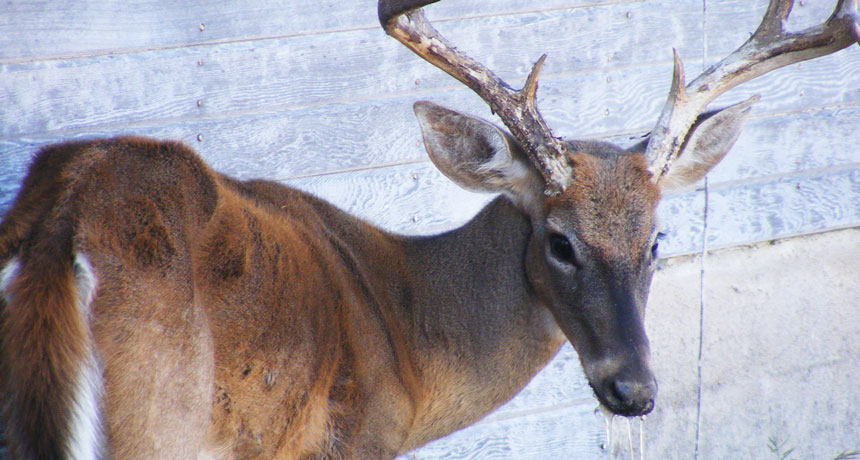An acid found in soil may make a disease killing deer less infectious
The incurable neurodegenerative disease is crippling deer, elk and moose populations

TRACKING INFECTION Chronic wasting disease has crippled deer, elk and moose populations throughout the northern hemisphere. But scientists have identified an organic soil compound, humic acid, that may prevent its spread.
Mike Hopper/Kansas Dept. of Wildlife, Parks & Tourism
- More than 2 years ago
An acid found in rich humus soil breaks down the misfolded brain proteins — called prions — that cause chronic wasting disease.
When concentrations of humic acid similar to those found in soils were applied to diseased elk brain tissue, chemical signatures of the infectious prions were nearly erased, researchers report online November 29 in PLOS Pathogens. That suggests that the acid somehow degrades the warped protein, making it less infectious, says Judd Aiken, a prion disease researcher at the University of Alberta in Edmonton, Canada.
Chronic wasting disease, an incurable neurodegenerative disease, has devastated populations of deer, elk and moose across parts of North America, South Korea, Sweden and Norway. We know “that environmental sources of infectivity play a role in transmission of these diseases,” Aiken says. The twisted proteins lurk in the rotting carcasses, feces or saliva of infected animals, and eventually seep into soils. The infection spreads when deer graze in prion-contaminated areas.
Previous studies have shown that soil mineralogy can influence the spread of prions, says Bryan Richards, a wildlife biologist with the U.S. Geological Survey’s National Wildlife Health Center in Madison, Wis., who was not involved in the study. For example, prions easily bind to microscopic minerals such as quartz, kaolinite and montmorillonite, and can — as lab tests have revealed — stay locked in soil for years.
Prions are a malformed version of proteins that cause nearby normal proteins of the same kind to take on this complex shape that is harmful to nerve cells. Infected animals become listless, disoriented and unable to chew their food or drink water for months until death.
Unlike mad cow disease, another fatal prion-related disorder, there is currently no evidence that chronic wasting disease can transfer to humans. Still, little is known about the transmission barrier between species, and scientists aren’t ruling out the possibility. If chronic wasting disease continues to ravage deer and elk populations, more humans may come into contact with the tainted animals through hunting and farming.
But the discovery of how humic acid affects prions may provide a way to track or even prevent the disease from taking hold.
Since levels of humic acid vary in nature, scientists exposed infected elk brain tissue to one, 2.5 and 25 grams per liter of commercially produced humic acid, and let it incubate overnight. In tissue samples with higher concentrations of humic acid, chemical signatures left by the infectious prions decreased by as much as 95 percent, signaling that the prions had likely broken down. The team also tested humic acid extracted from soil samples collected throughout western Canada and noted a similar decrease in prion signatures.
Next, researchers injected some mice with a mixture of humic acid and infected elk brain tissue. Others were given a noninfected mixture. The team then monitored the mice during a roughly yearlong incubation period. Higher doses of humic acid correlated to weaker prion signals in the infected mice. In roughly half the cases, the mice injected with the infected brain tissue and humic acid mixture didn’t show any symptoms at all after a 280-day incubation period.
The results suggest that humic acid could be used in efforts to limit the disease’s spread — possibly as a soil decontaminant to disinfect farmland. Previously, high levels of a mineral called birnessite were also found to degrade prions, therefore limiting transmission of the disease.
Alternatively, scientists could use this information to map which geographic areas elevate or inhibit prion transmission based on the levels of humic acid in the soil, says Shannon Bartelt-Hunt, an environmental engineer at the University of Nebraska–Lincoln who was not involved in the research. The next step, Bartelt-Hunt says, might be to test the effects of humic acid on prion-contaminated soil samples to see if prions can be eradicated in the environment.







